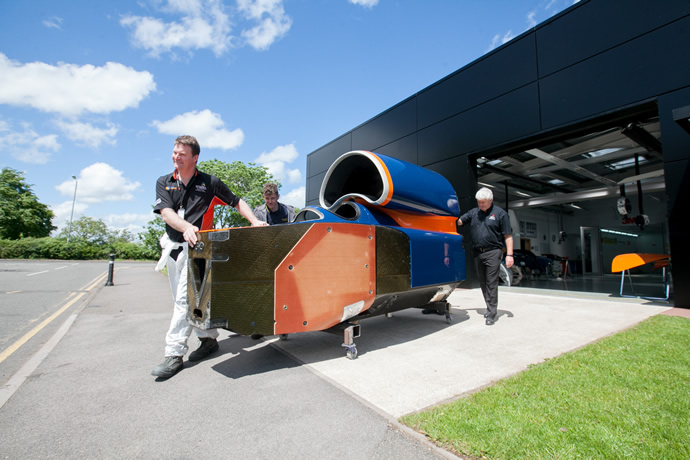Finishing touches for world’s fastest car
A supersonic car expected to smash the land speed record has returned to 3M’s Atherstone facility for a final paint job, which will be more than just cosmetic.
Powered by hybrid rockets and a Eurofighter Typhoon jet engine, the Bloodhound SSC will attempt to surpass 1,000mph – faster than a bullet – in South Africa in 2018.
The design team is confident of going well beyond the current land speed record of 763.065mph, set in 1997 by the world’s first supersonic car, the Thrust SSC.
To that end, every aspect of the car has been designed for speed, including the distinctive blue and orange paintwork, which needs to be ultra-smooth and lightweight.
Work on the upper chassis began at the site on 19th December, after the vehicle’s front half was painted there in May 2015. At nearly 5.5 metres long, the titanium skinned back section is the car’s largest single part. It houses everything behind the cockpit, including the jet engine, rocket motor and air brakes.
Simon Evans, of paintbysimon.com, will spend a week single-handedly spraying the section with a single layer of aircraft paint. Simon has worked on such high profile projects as the CNN Hummer ‘Warrior One’ and other vehicles for films, as well as appearing on television programmes about cars.

He said: “The idea is to have the vehicle as smooth as possible to reduce turbulence on the skin, but without adding too much weight to the car. You need first class facilities, because you can’t have any contamination. Otherwise it would end up looking like the surface of the moon, and I’d have to start all over again.
“3M’s Atherstone facility is tailor-made for the job. It’s big enough, it’s climate controlled and it’s got a great spray booth, with all the preparation areas and stations right in front of it. Everything you need to prep and paint this vehicle is right on hand and ready to go. It works so seamlessly.”
He added: “It’s great to be working with professional companies like 3M. They’re at the top of their game, so for them to be involved makes perfect sense.”
In addition to its facilities, 3M’s adhesives have been used to bond parts made of carbon fibre and other composite materials, ensuring the car is as lightweight and durable as possible.
3M technical supervisor Gavin Phipps said: “We couldn’t miss the chance to be a part of the production of this amazing vehicle. We hope 3M’s contribution, from both our products and our facilities, will help the Bloodhound to make history.
“The purpose of this project, aside from breaking a world record, is to inspire the next generation of scientists and engineers, so it fits well with 3M’s work. It’s a perfect example of what we do here every day.”
The Bloodhound is 13.47 metres long and three metres tall, weighing 7.5 tonnes. Its engines generate a combined 135,000 thrust horsepower, equivalent to 180 Formula One cars.
The car has been designed to reach speeds of up to 1,050mph, meaning it will be able to travel the length of four-and-a-half football pitches in one second. Three brake types are needed to stop the vehicle: the air brake will be used at 800mph, parachutes will be deployed at 600mph and a friction brake will kick in at 200mph.
The engineering feat is being used to encourage youngsters to study the STEM subjects of science, technology, engineering and mathematics. A full scale replica of the car has been touring the country, gaining national media attention.
The car, which will be driven by RAF fighter pilot Andy Green, is scheduled for low speed testing of up to 200mph in Newquay, Cornwall in summer next year. It will then be taken to a perfectly flat area of the Kalahari Desert in South Africa, for testing at up to 800mph in October 2017, before returning there the following year for the record attempt.










